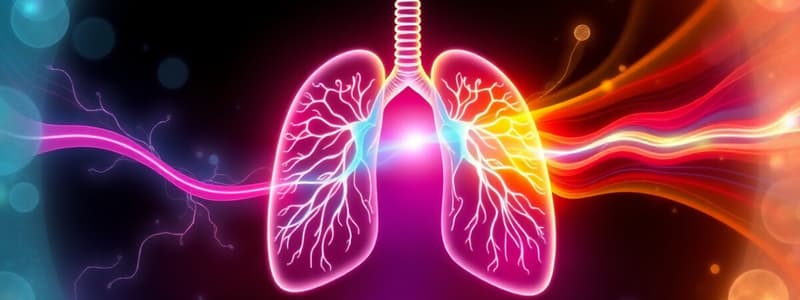Podcast
Questions and Answers
What percentage of energy released during aerobic cellular respiration is stored in ATP molecules?
What percentage of energy released during aerobic cellular respiration is stored in ATP molecules?
- 50%
- 80%
- 36% (correct)
- 64%
In which part of the body does gas exchange primarily occur for multicellular animals?
In which part of the body does gas exchange primarily occur for multicellular animals?
- Kidneys
- Lungs (correct)
- Liver
- Brain
Which equation represents the conversion of ATP back to ADP?
Which equation represents the conversion of ATP back to ADP?
- ATP → ADP + P + Energy (correct)
- ATP + P → ADP + Energy
- ATP → ADP + O2
- ADP + Energy → ATP
What is the process called by which oxygen and carbon dioxide are exchanged at the cellular level?
What is the process called by which oxygen and carbon dioxide are exchanged at the cellular level?
Which of the following best describes ventilation?
Which of the following best describes ventilation?
What is the function of cilia in the respiratory system?
What is the function of cilia in the respiratory system?
Why is the respiratory membrane described as being 'incredibly thin'?
Why is the respiratory membrane described as being 'incredibly thin'?
During inspiration, which of the following occurs?
During inspiration, which of the following occurs?
What percentage of oxygen is typically found in the atmosphere?
What percentage of oxygen is typically found in the atmosphere?
What is the role of erythropoietin (EPO) when oxygen supply is reduced?
What is the role of erythropoietin (EPO) when oxygen supply is reduced?
Which of the following volumes is included in the calculation of vital capacity?
Which of the following volumes is included in the calculation of vital capacity?
At high altitudes, what primarily limits oxygen availability to the body?
At high altitudes, what primarily limits oxygen availability to the body?
How much oxygen is typically carried by hemoglobin compared to blood plasma?
How much oxygen is typically carried by hemoglobin compared to blood plasma?
What mainly causes carbon dioxide to diffuse from tissues into the bloodstream?
What mainly causes carbon dioxide to diffuse from tissues into the bloodstream?
Which gas primarily triggers an increase in breathing rate due to its acidity effect on plasma?
Which gas primarily triggers an increase in breathing rate due to its acidity effect on plasma?
What is the primary function of the residual volume in the lungs?
What is the primary function of the residual volume in the lungs?
What happens during expiration in terms of diaphragm movement?
What happens during expiration in terms of diaphragm movement?
What characterizes the alveoli in terms of their structure?
What characterizes the alveoli in terms of their structure?
What is the total atmospheric pressure at sea level?
What is the total atmospheric pressure at sea level?
Flashcards
Aerobic Cellular Respiration
Aerobic Cellular Respiration
The process by which cells break down glucose using oxygen to produce energy, releasing carbon dioxide and water as byproducts.
ATP
ATP
A high-energy molecule used by cells to power various processes like growth, movement, and building new molecules.
Ventilation (Breathing)
Ventilation (Breathing)
The process of moving oxygen-rich air into the lungs and carbon dioxide-rich air out of the lungs.
Gas Exchange
Gas Exchange
Signup and view all the flashcards
Gas Exchange in Multicellular Organisms
Gas Exchange in Multicellular Organisms
Signup and view all the flashcards
Respiratory Membrane
Respiratory Membrane
Signup and view all the flashcards
Alveoli
Alveoli
Signup and view all the flashcards
Partial Pressure
Partial Pressure
Signup and view all the flashcards
Pressure Gradient
Pressure Gradient
Signup and view all the flashcards
Ventilation
Ventilation
Signup and view all the flashcards
Hemoglobin
Hemoglobin
Signup and view all the flashcards
Oxygen Transport
Oxygen Transport
Signup and view all the flashcards
Carbon Dioxide Transport
Carbon Dioxide Transport
Signup and view all the flashcards
Hypoxia
Hypoxia
Signup and view all the flashcards
Erythropoietin (EPO)
Erythropoietin (EPO)
Signup and view all the flashcards
Total Lung Capacity
Total Lung Capacity
Signup and view all the flashcards
Tidal Volume
Tidal Volume
Signup and view all the flashcards
Inspiratory Reserve Volume
Inspiratory Reserve Volume
Signup and view all the flashcards
Expiratory Reserve Volume
Expiratory Reserve Volume
Signup and view all the flashcards
Residual Volume
Residual Volume
Signup and view all the flashcards
Study Notes
Aerobic Cellular Respiration
- Glucose reacts with oxygen to produce carbon dioxide and water, releasing energy
- Approximately 64% of the energy released is thermal energy
- About 36% is stored in ATP (adenosine triphosphate) molecules
- ATP powers cellular processes like growth, movement, and molecule building.
- ATP is formed from ADP (adenosine diphosphate) and a phosphate group through the addition of energy.
Gas Exchange and Ventilation
- Gas exchange is oxygen diffusion into cells and carbon dioxide diffusion out of cells.
- Simple organisms exchange gases directly across their cell membranes.
- Larger, multicellular organisms have organ systems to facilitate gas exchange between cells and the environment.
- Gas exchange occurs in lungs and cells.
- Lungs exchange oxygen from air into the blood, and carbon dioxide out of the blood and into the air.
- Cells receive oxygen from tissue fluid and release carbon dioxide to the bloodstream.
- Ventilation (breathing) moves air in and out of the lungs.
Respiratory Structures
- The human respiratory system has features like a thin, permeable, respiratory membrane, and large surface area for gas exchange with a good blood supply.
- The system ensures oxygen-rich air reaches the respiratory membrane in the lungs.
- The respiratory tract includes the nose, nasal passages, mouth, pharynx, trachea, bronchi, bronchioles, and alveoli.
- The trachea contains cartilage to maintain its shape, mucus-producing cells and cilia to trap and remove foreign materials.
- Alveoli are tiny sacs clustered in the lungs, essential for gas exchange, each with a high surface area surrounded by capillaries.
Gas Exchange in Alveoli
- Alveoli are filled with air at body temperature and humidity.
- Oxygen diffuses across the thin respiratory membrane into blood, only dissolved in the liquid components.
- The thin, one-cell-thick membrane is well-suited for efficient gas exchange.
Partial Pressures
- Air pressure varies with altitude.
- Partial pressure is the pressure exerted by individual gases in a mixture.
- Oxygen makes up approximately 20.9% of atmospheric air.
- Carbon dioxide is approximately 0.0391% of air.
- Partial pressures drive gas exchange.
Oxygen Transport and Diffusion
- The partial pressure of oxygen in the alveoli is higher than in the blood, so oxygen diffuses into the blood.
- Hemoglobin, an iron-containing protein, binds to oxygen forming oxyhemoglobin.
- Hemoglobin significantly enhances oxygen transport in the blood.
- At tissues, oxygen diffuses from the blood into cells.
Carbon Dioxide Transport and Diffusion
- Carbon dioxide is a cellular byproduct that must be removed.
- Carbon dioxide diffuses from cells into the blood.
- Some CO2 dissolves in plasma, some binds to hemoglobin, most is converted to bicarbonate ions.
- Bicarbonate and hydrogen ions are transported in blood to the lungs
- Pressure differences drive the diffusion of CO2 from the blood into the alveoli.
Altitude and Gas Exchange
- Atmospheric pressure and partial pressures decrease with altitude.
- Lower oxygen pressure at high altitudes leads to decreased gas exchange and oxygen supply, potentially causing altitude sickness.
- The body adapts by increasing red blood cell production to compensate for reduced oxygen availability.
Mechanism of Ventilation
- Inspiration: External intercostal muscles and diaphragm contract to increase thoracic cavity volume, decreasing lung pressure, allowing air to enter the lungs.
- Expiration: External intercostal muscles and diaphragm relax, decreasing thoracic cavity volume, increasing lung pressure, forcing air out of the lungs.
Lung Capacity
- Total Lung Capacity (TLC): Maximum air volume in lungs during inhalation.
- Tidal Volume (TV): Normal, involuntary breath volume.
- Inspiratory Reserve Volume (IRV): Air forcibly inhaled after tidal volume.
- Expiratory Reserve Volume (ERV): Air forcibly exhaled after tidal volume.
- Residual Volume (RV): Air remaining in lungs after forced exhalation (vital for preventing lung collapse).
- Vital Capacity (VC): Maximum air exhaled. (VC = TV + IRV + ERV)
Studying That Suits You
Use AI to generate personalized quizzes and flashcards to suit your learning preferences.




